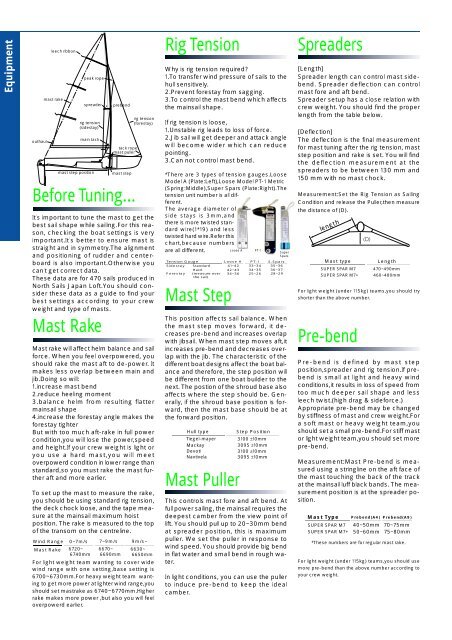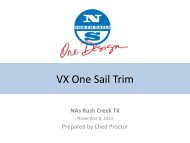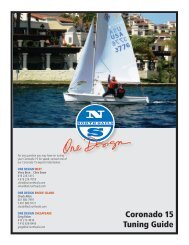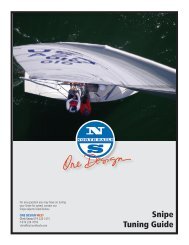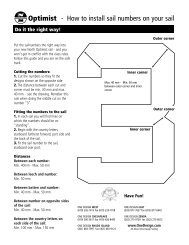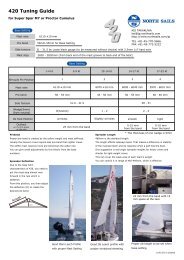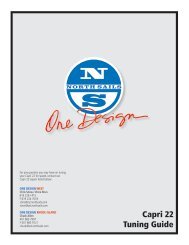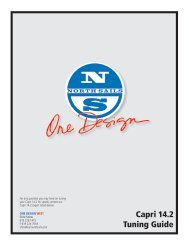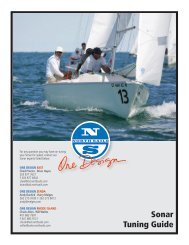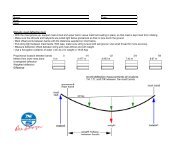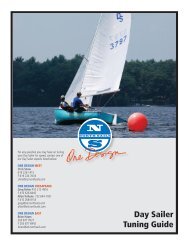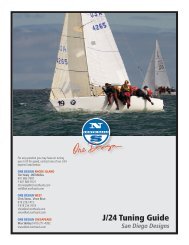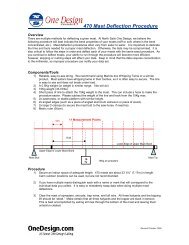470 Tuning Guide E01 - North Sails - One Design
470 Tuning Guide E01 - North Sails - One Design
470 Tuning Guide E01 - North Sails - One Design
Create successful ePaper yourself
Turn your PDF publications into a flip-book with our unique Google optimized e-Paper software.
Equipment<br />
outhaul<br />
leech ribbon<br />
mast rake<br />
peak rope<br />
spreader<br />
rig tension<br />
(sidestay)<br />
main tack<br />
mast step position<br />
prebend<br />
tack rope<br />
mast puller<br />
mast step<br />
Before <strong>Tuning</strong>...<br />
rig tension<br />
(forestay)<br />
It`s important to tune the mast to get the<br />
best sail shape while sailing.For this reason,<br />
checking the boat settings is very<br />
important.It`s better to ensure mast is<br />
straight and in symmetry.The alignment<br />
and positioning of rudder and centerboard<br />
is also important.Otherwise you<br />
can`t get correct data.<br />
These data are for <strong>470</strong> sails produced in<br />
<strong>North</strong> <strong>Sails</strong> Japan Loft.You should consider<br />
these data as a guide to find your<br />
best settings according to your crew<br />
weight and type of masts.<br />
Mast Rake<br />
Mast rake will affect helm balance and sail<br />
force. When you feel overpowered, you<br />
should rake the mast aft to de-power. It<br />
makes less overlap between main and<br />
jib.Doing so will:<br />
1.increase mast bend<br />
2.reduce heeling moment<br />
3.balance helm from resulting flatter<br />
mainsail shape<br />
4.increase the forestay angle makes the<br />
forestay tighter<br />
But with too much aft-rake in full power<br />
condition,you will lose the power,speed<br />
and height.If your crew weight is light or<br />
you use a hard mast,you will meet<br />
overpowerd condition in lower range than<br />
standard,so you must rake the mast further<br />
aft and more earlier.<br />
To set up the mast to measure the rake,<br />
you should be using standard rig tension,<br />
the deck chock loose, and the tape measure<br />
at the mainsail maximum hoist<br />
position. The rake is measured to the top<br />
of the transom on the centreline.<br />
Wind Range 0~7m/s 7~9m/s 9m/s~<br />
Mast Rake 6720~<br />
6740mm<br />
6670~<br />
6690mm<br />
6630~<br />
6650mm<br />
For light weight team wanting to cover wide<br />
wind range with one setting,base setting is<br />
6700~6730mm.For heavy weight team wanting<br />
to get more power at lighter wind range,you<br />
should set mastrake as 6740~6770mm.Higher<br />
rake makes more power ,but also you will feel<br />
overpowerd earlier.<br />
Rig Tension<br />
Why is rig tension required?<br />
1.To transfer wind pressure of sails to the<br />
hull sensitively.<br />
2.Prevent forestay from sagging.<br />
3.To control the mast bend which affects<br />
the mainsail shape.<br />
If rig tension is loose,<br />
1.Unstable rig leads to loss of force.<br />
2.Jib sail will get deeper and attack angle<br />
will become wider which can reduce<br />
pointing.<br />
3.Can not control mast bend.<br />
*There are 3 types of tension gauges.Loose<br />
Model A (Plate:Left),Loose Model PT-1 Metric<br />
(Spring:Middle),Super Spars (Plate:Right).The<br />
tension unit number is all different.<br />
The average diameter of<br />
side stays is 3mm,and<br />
there is more twisted standard<br />
wire(1*19) and less<br />
twisted hard wire.Refer this<br />
chart,because numbers<br />
are all different.<br />
Loose APT-1<br />
Super<br />
Spars<br />
Tension Gauge Loose A PT-1 S.Spars<br />
Sidestay Standard 41~42 33~34 35~36<br />
Hard<br />
42~43 34~35 36~37<br />
Forestay (measure over 34~36 25~26 28~29<br />
the sail)<br />
Mast Step<br />
This position affects sail balance. When<br />
the mast step moves forward, it decreases<br />
pre-bend and increases overlap<br />
with jibsail. When mast step moves aft,it<br />
increases pre-bend and decreases overlap<br />
with the jib. The characteristic of the<br />
different boat designs affect the boat balance<br />
and therefore, the step position will<br />
be different from one boat builder to the<br />
next. The postion of the shroud base also<br />
affects where the step should be. Generally,<br />
if the shroud base position is forward,<br />
then the mast base should be at<br />
the forward position.<br />
Hull type<br />
Tiegel-mayer<br />
Mackay<br />
Devoti<br />
Navtivela<br />
Mast Puller<br />
Step Position<br />
3100 ±10mm<br />
3095 ±10mm<br />
3100 ±10mm<br />
3095 ±10mm<br />
This controls mast fore and aft bend. At<br />
full power sailing, the mainsail requires the<br />
deepest camber from the view point of<br />
lift. You should pull up to 20~30mm bend<br />
at spreader position, this is maximum<br />
puller. We set the puller in response to<br />
wind speed. You should provide big bend<br />
in flat water and small bend in rough water.<br />
In light conditions, you can use the puller<br />
to induce pre-bend to keep the ideal<br />
camber.<br />
Spreaders<br />
[Length]<br />
Spreader length can control mast sidebend.<br />
Spreader deflection can control<br />
mast fore and aft bend.<br />
Spreader setup has a close relation with<br />
crew weight. You should find the proper<br />
length from the table below.<br />
[Deflection]<br />
The deflection is the final measurement<br />
for mast tuning after the rig tension, mast<br />
step position and rake is set. You will find<br />
the deflection measurement at the<br />
spreaders to be between 130 mm and<br />
150 mm with no mast chock.<br />
Measurement:Set the Rig Tension as Sailing<br />
Condition and release the Puller,then measure<br />
the distance of (D).<br />
<br />
Mast type<br />
SUPER SPAR M7<br />
SUPER SPAR M7+<br />
Pre-bend<br />
Length<br />
<strong>470</strong>~490mm<br />
460~480mm<br />
For light weight (under 115kg) teams,you should try<br />
shorter than the above number.<br />
Pre-bend is defined by mast step<br />
position,spreader and rig tension.If prebend<br />
is small at light and heavy wind<br />
conditions,it results in loss of speed from<br />
too much deeper sail shape and less<br />
leech twist.(high drag & sideforce.)<br />
Appropriate pre-bend may be changed<br />
by stiffness of mast and crew weight.For<br />
a soft mast or heavy weight team,you<br />
should set a small pre-bend.For stiff mast<br />
or light weight team,you should set more<br />
pre-bend.<br />
Measurement:Mast Pre-bend is measured<br />
using a stringline on the aft face of<br />
the mast touching the back of the track<br />
at the mainsail luff black bands. The measurement<br />
position is at the spreader position.<br />
Mast Type<br />
SUPER SPAR M7<br />
SUPER SPAR M7+<br />
Prebend(A4) Prebend(A9)<br />
40~50mm<br />
50~60mm<br />
70~75mm<br />
75~80mm<br />
*These numbers are for regular mast rake.<br />
For light weight (under 115kg) teams,you should use<br />
more pre-bend than the above number according to<br />
your crew weight.


